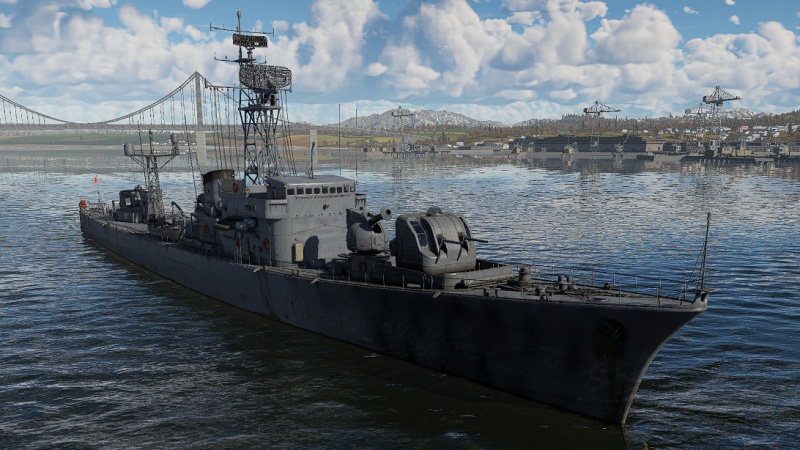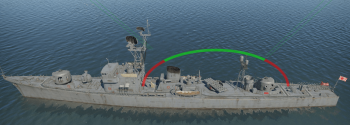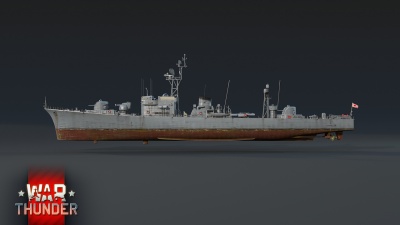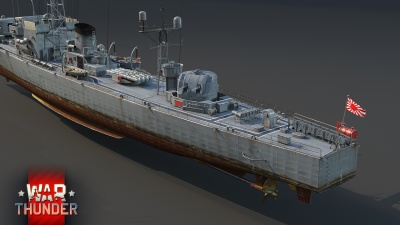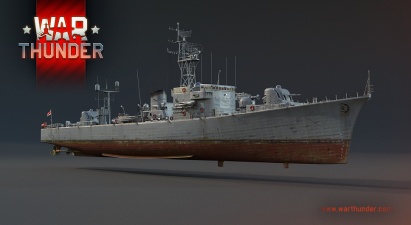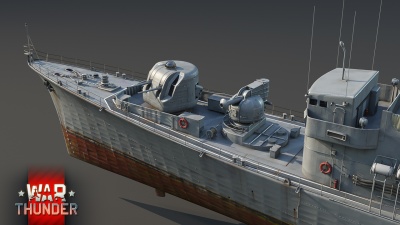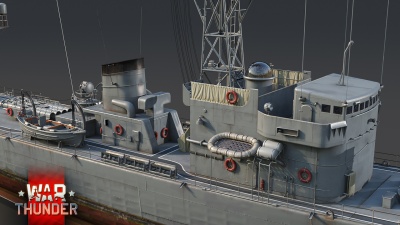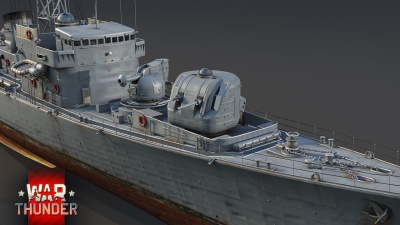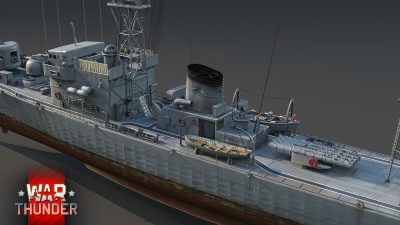Isuzu
| This page is about the Japanese frigate Isuzu. For other uses, see Isuzu (Disambiguation). |
Contents
Description
The Isuzu-class, JDS Isuzu (DE-211) (いすず, namesake: Isuzu River) was the lead ship of a series of four destroyer escorts for the JMSDF. The development of the Isuzu-class emerged following the initial reliance on a vast number of loaned vessels at the inception of the JMSDF. While there was a domestic focus on constructing Type A Patrol Ships (DD), the construction of Type B Patrol Ships (DE) was neglected. However, the need for replacement vessels became apparent as older ships were scheduled for retirement. This led to a shift in plans, resulting in the construction of new Type B Patrol Ships under the 1959 plan. During her service, Isuzu was primarily used to patrol Japanese coastal waters. The ship was withdrawn from the fleet in 1988, but it remained in service as the auxiliary vessel JDS Isuzu (ASU-7015). She was finally decommissioned in 1995.
Isuzu was introduced into the game in Update 1.95 "Northern Wind". The primary weapon on the Isuzu consists of four 3-inch Mk.33 automatic cannons in twin installations, capable of firing HE, HE-VT, or APHE shells. This configuration allows it to engage any target with a rapid-fire rate at mid-to-short range. Additionally, she is equipped with torpedoes and uniquely features a Mark 108 Weapon Alfa launcher. This launcher fires a RUR-4 anti-submarine rocket with an explosive mass of 113 kg of TNT at a velocity of 306 m/s, although it is limited to only 800 metres, relegating it to a close-range or last-resort weapon. As Isuzu is equipped only with her main guns and anti-submarine equipment, anti-aircraft duty is left to the manual fire of the main guns, preferably using HE-VT shells.
General info
Survivability and armour
Talk about the vehicle's armour. Note the most well-defended and most vulnerable zones, e.g. the ammo magazine. Evaluate the composition of components and assemblies responsible for movement and manoeuvrability. Evaluate the survivability of the primary and secondary armaments separately. Don't forget to mention the size of the crew, which plays an important role in fleet mechanics. Save tips on preserving survivability for the "Usage in battles" section. If necessary, use a graphical template to show the most well-protected or most vulnerable points in the armour.
Mobility
Write about the ship's mobility. Evaluate its power and manoeuvrability, rudder rerouting speed, stopping speed at full tilt, with its maximum forward and reverse speed.
| Mobility Characteristics | |||
|---|---|---|---|
| Game Mode | Upgrade Status | Maximum Speed (km/h) | |
| Forward | Reverse | ||
| AB | |||
| Upgraded | |||
| RB/SB | |||
| Upgraded | |||
Modifications and economy
Armament
Primary armament
Isuzu carries four 3-inch Mk.33 automatic cannons in twin installation. The turrets are placed at the front and back of the ship and can effectively cover your vessel from all sides. HE shells can take care of unarmoured targets especially small boats which can be destroyed within a few shots. For armoured targets and destroyers, you can choose APHE shells but you still have to keep in mind that it is a 76 mm multi-purpose cannon. HE-VT shells are good for use in AA roles as there is not any secondary armament you can rely on.
| Penetration statistics | |||||||
|---|---|---|---|---|---|---|---|
| Ammunition | Type of warhead |
Penetration @ 0° Angle of Attack (mm) | |||||
| 100 m | 1,000 m | 2,000 m | 3,000 m | 4,000 m | 5,000 m | ||
| HC Mk.27 | HE | 8 | 8 | 8 | 8 | 8 | 8 |
| APHE | APHE | 121 | 98 | 77 | 61 | 49 | 39 |
| Shell details | ||||||||||||
|---|---|---|---|---|---|---|---|---|---|---|---|---|
| Ammunition | Type of warhead |
Velocity (m/s) |
Projectile mass (kg) |
Fuse delay (s) |
Fuse sensitivity (mm) |
Explosive mass (TNT equivalent) (g) |
Ricochet | |||||
| 0% | 50% | 100% | ||||||||||
| HC Mk.27 | HE | 823 | 5.9 | 0 | 0.1 | 500 | 79° | 80° | 81° | |||
| APHE | APHE | 823 | 5.9 | 0.01 | 4 | 63.7 | 47° | 60° | 65° | |||
| Proximity-fused shell details | ||||||||||||
|---|---|---|---|---|---|---|---|---|---|---|---|---|
| Ammunition | Type of warhead |
Velocity (m/s) |
Projectile mass (kg) |
Fuse delay (m) |
Fuse sensitivity (mm) |
Arming distance (m) |
Trigger radius (m) |
Explosive mass (TNT equivalent) (g) |
Ricochet | |||
| 0% | 50% | 100% | ||||||||||
| AA Mk.31 | HE-VT | 823 | 5.85 | 0 | 0.1 | 548 | 15 | 352.8 | 79° | 80° | 81° | |
Additional armament
As one of the special armaments, this ship carries Mark 108 Weapon alfa without any upgrades. This is an anti-submarine rocket, but in-game you can only use it for close-range combat against ships. It shoots RUR-4 rockets that have a speed of 306 km/h and carries 113 kg of TNT, which is equal to small torpedoes. The biggest disadvantage is the range, which is only 800 m especially, combined with the fact that fast boats can easily dodge these rockets. Blindspot in front of the ship (thanks to the main armament turret) makes this weapon very situational.
After unlocking the "Bomb mortar" upgrade, you can equip 2 x Mk. 6 depth charges which are projected from mortars. These weapons have an extremely limited range (only a few hundred metres off each side of the ship) and would only be used during a close-in brawl. Keep in mind that the depth charges do take a few seconds to fly through the air and sink before they detonate, so be aware of timing their firing. Each Mk. 6 depth charge has an explosive charge of 136 kg TNT, which will obliterate any small craft and deal significant damage to a larger ship.
Usage in battles
Isuzu has upgraded firepower from its in-game predecessor Chikugo but it shares the same imperfections of not very long-range and small calibre compared to opponents you will meet. That means you should stick to the same tactics that work for Chikugo, such as not attempting to battle against long-range destroyers and rather focusing on boats and sub-chasers. You should not take this ship into the late game as there isn't any anti-air armament and you will be easy prey for bombers that can overwhelm you if coming from different directions.
Pros and cons
Pros:
- Radar
- Main guns can engage variety of targets
- Guns have high rate of fire
- Mark 108 missiles are effective against close targets
Cons:
- Guns overheat quickly
- No secondary or anti-aircraft armament
- Slow compared to destroyers
- Destroyer spawn
History
Devblog
During the late 1950's, the Japanese Maritime Self-Defence Force (JMSDF) was planning on expanding their destroyer fleet with a number of new ships intended to complement the recently modernized destroyers leased from the US Navy. However, these plans were revised shortly afterwards due to the JMSDF realizing that their frigates in service at the time, as well as being older leased US vessels, were starting to show their age and were getting ever closer to their planned retirement, scheduled for the early 1960's.
As a result, development of a new frigate began in the late 1950's, eventually resulting in the creation of the Isuzu-class. The first two ships of the class, Isuzu and Mogami, were laid down in April and August of 1960, respectively, while the remaining two ships, Kitakami and Ōi, were both laid down in June of 1962.
The first batch of ships entered service with the JMSDF in 1961, with the other half being commissioned in 1964. Ships of the Isuzu-class served faithfully with the JMSDF until they were decommissioned in the early 1990's, also serving as a base for the development of its successor design - the Chikugo-class - shortly after their introduction.
Media
- Skins
- Images
See also
Links to articles on the War Thunder Wiki that you think will be useful for the reader, for example:
- reference to the series of the ship;
- links to approximate analogues of other nations and research trees.
External links
| Mitsui Shipbuilding and Engineering Co. (三井造船) | |
|---|---|
| Destroyer Escorts (DE) | |
| Isuzu-class | Isuzu |
| Chikugo-class | Chikugo |
| Japan frigates | |
|---|---|
| IJN | |
| Escort | IJN Syonan |
| JMSDF | |
| Destroyer Escort | JDS Akebono · JDS Ikazuchi · JDS Isuzu · JDS Chikugo |
| Destroyer | JDS Ayanami |



